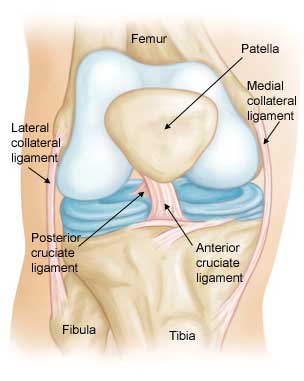
Collateral Ligaments Tear( LCL/MCL)
 These are found on the sides of your knee. The collateral ligaments control the sideways motion of your knee and brace it against unusual movement.
These are found on the sides of your knee. The collateral ligaments control the sideways motion of your knee and brace it against unusual movement.
LCL- The lateral or "outside" collateral ligament (LCL) connects the femur to the smaller bone in the lower leg (fibula).
MCL- The medial or "inside" collateral ligament (MCL) connects the femur to the tibia.
Injured ligaments are considered "sprains" and are graded on a severity scale.
Grade 1 Sprains: The ligament is mildly damaged in a Grade 1 Sprain. It has been slightly stretched, but is still able to help keep the knee joint stable.
Grade 2 Sprains: A Grade 2 Sprain stretches the ligament to the point where it becomes loose. There is a partial tear of the ligament.
Grade 3 Sprains: This type of sprain there is a complete tear of the ligament. The ligament has been split into two pieces, and the knee joint is unstable.
The MCL is injured more often than the LCL.
Cause -
1. Injury bcoz of force that pushes the knee sideways.
2. Medial collateral ligament tears often occur as a result of a direct blow to the outside of the knee. This pushes the knee inwards (toward the other knee).
3. Blows to the inside of the knee that push the knee outwards may injure the lateral collateral ligament.
Symptoms -
1. Pain at the sides of your knee. If there is an MCL injury, the pain is on the inside of the knee.
2. An LCL injury may cause pain on the outside of the knee.
3. Swelling over the site of the injury.
4. Instability — the feeling that your knee is giving way.
Investigation -
x-ray and MRI
Physiotherapy Treatment-
• Icing
• Bracing
• Strengthening exercises
• Modalities for pain relief.
• Postural guidance

